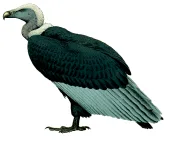
White-rumped Vulture
Subspecies
| Genus | Species | subspecies | Region | Range |
| Gyps | bengalensis | OR | Iran through Southeast Asia |
Genus
Members of the genus Gyps are vultures varying in size from medium to large. They have an elongated head with a long and heavy beak. The head and neck are bare, but for a covering of woolly down. At the base of the neck is a ruff of long, narrow, pointed feathers. This is a social genus, usually nesting in colonies in trees or on rocky crags. There are seven species, covering much of Africa, southern Europe and into Asia. Of there, two (the African White-backed Vulture Gyps africanus and the Indian White-backed Vulture Gyps bengalensis ) are arguably more logically places in a genus of their own. They differ in that they have 12 tail feathers (not the 14 that all other Gyps have), their nesting habits differ, and they have a distinctive coloration that differs significantly from the rest of the genus.
Physical charateristics
| wingspan min.: | 200 | cm | wingspan max.: | 220 | cm |
| size min.: | 75 | cm | size max.: | 85 | cm |
| incubation min.: | 45 | days | incubation max.: | 52 | days |
| fledging min.: | 85 | days | fledging max.: | 95 | days |
| broods: | 1 | eggs min.: | 1 | ||
| eggs max.: | 1 |
Range
Habitat
Reproduction
Feeding habits
Video White-rumped Vulture
copyright: J. del Hoyo
Conservation
By mid-2000, Gyps vultures were being found dead and dying in Nepal, Pakistan, and throughout India, and major declines and local extirpations were being reported. The anti-inflammatory veterinary drug diclofenac, used to treat domestic livestock, has been identified as the cause of mortality, with renal failure resulting in visceral gout in the vast majority of examined vultures. Modelling has shown that to cause the observed rate of decline in Gyps vultures, just one in 760 livestock carcasses need contain diclofenac residues. Despite awareness programmes to educate locals about the association between diclofenac and vulture mortality, a survey in Nepal indicated that the vast majority of people still do not link diclofenac use to a decline in vulture populations, potentially leading to a slower uptake of meloxicam. A second veterinary drug in use in India, ketoprofen, has also recently been identified to be lethal to the species, and population modelling indicates that it may be present in sufficient concentrations to also cause population declines. Other likely contributory factors are changes in human consumption and processing of dead livestock, non-target poisoning, avian malaria and pesticide use, but these are probably of minor significance. In South-East Asia, the near-total disappearance of the species pre-dated the present crisis, and probably resulted from the collapse of large wild ungulate populations and improved management of deceased livestock. One study recorded that the sex of fledglings, the sex of dead adults and the sex of adults with visceral gout were all male-biased which may lead to problems in the future.

Migration
Distribution map

